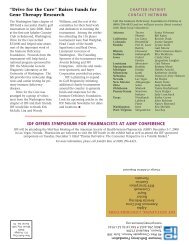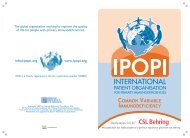IDF Patient & Family Handbook for Primary Immunodeficiency ... - IDFA
IDF Patient & Family Handbook for Primary Immunodeficiency ... - IDFA
IDF Patient & Family Handbook for Primary Immunodeficiency ... - IDFA
Create successful ePaper yourself
Turn your PDF publications into a flip-book with our unique Google optimized e-Paper software.
Chronic Granulomatous Disease 33<br />
Diagnosis of Chronic Granulomatous Disease<br />
Because the most common genetic type of CGD<br />
affects only boys, it may be mistakenly assumed that<br />
CGD cannot affect girls. However, there are several<br />
genetic types of CGD, and some do affect girls. In<br />
fact, about 15% of all CGD patients are girls.<br />
CGD can vary in its severity and there is a certain<br />
amount of chance as to when a patient with<br />
CGD develops a severe infection. For this reason<br />
there are some CGD patients that may not have<br />
an infection that draws attention to the disease<br />
until late adolescence or even adulthood. While<br />
it is more common to see infections that lead<br />
to diagnosis in early childhood, surprisingly, the<br />
average age of diagnosis of boys with CGD is<br />
about three years old and of girls, seven years<br />
old. It is important <strong>for</strong> pediatricians and internists<br />
caring <strong>for</strong> adolescents and young adults not to<br />
completely dismiss the possibility of a diagnosis of<br />
CGD in a young adult patient who gets pneumonia<br />
with an unusual organism like the Aspergillus<br />
fungus. Any patient of any age who presents with<br />
an Aspergillus, Nocardia or Burkholderia cepacia<br />
pneumonia, a staphylococcus liver abscess or<br />
pneumonia, or a bone infection with Serratia<br />
marcescens should be tested to rule out CGD.<br />
These are the usual combinations of organisms<br />
and sites of infection that commonly trigger testing<br />
<strong>for</strong> CGD. By contrast, merely having an occasional<br />
staphylococcal infection of the skin is not<br />
particularly a special sign of CGD, nor is recurrent<br />
middle ear infections, though CGD patients can<br />
also suffer from these problems.<br />
The most accurate test <strong>for</strong> CGD measures the<br />
production of hydrogen peroxide in phagocytic<br />
cells. Hydrogen peroxide produced by normal<br />
phagocytes oxidizes a chemical called<br />
Dihydrorhodamine, making it fluorescent and the<br />
fluorescence is measured with a sophisticated<br />
machine. In contrast, phagocytic cells from<br />
CGD patients cannot produce enough hydrogen<br />
peroxide to make the dihydrorhodamine fluoresce.<br />
There are other types of tests still used to<br />
diagnose CGD, such as the Nitroblue Tetrazolium<br />
(NBT) slide test. The NBT is a visual test in which<br />
phagocytes producing oxidants turn blue and are<br />
scored manually using a microscope. It is more<br />
prone to human subjective assessment and can<br />
lead to false negatives, occasionally missing the<br />
diagnosis of CGD in patients with mild <strong>for</strong>ms<br />
of CGD, where cells may turn slightly blue, but<br />
actually are abnormal.<br />
Once a diagnosis of CGD is made, there are<br />
a few specialized labs that can confirm the genetic<br />
sub-type of CGD.<br />
Inheritance Pattern of Chronic<br />
Granulomatous Disease<br />
Chronic Granulomatous Disease (CGD) is a<br />
genetically determined disease and can be<br />
inherited or passed on in families. There are two<br />
patterns <strong>for</strong> transmission. One <strong>for</strong>m of the disease<br />
affects about 75% of cases and is inherited in<br />
a sex-linked (or X-linked) recessive manner;<br />
i.e. it is carried on the “X” chromosome. Three<br />
other <strong>for</strong>ms of the disease are inherited in an<br />
autosomal recessive fashion. They are carried on<br />
chromosomes other than the “X” chromosome<br />
(see chapter titled Inheritance). It is important to<br />
understand the type of inheritance so families can<br />
understand why a child has been affected, the risk<br />
that subsequent children may be affected, and the<br />
implications <strong>for</strong> other members of the family.
















